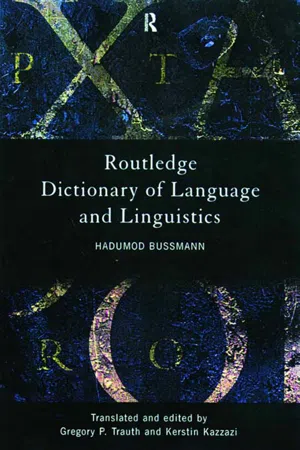Languages & Linguistics
Dative
In linguistics, the dative case is a grammatical case used to indicate the indirect object of a verb, typically showing the recipient of an action or the person for whom something is done. It is found in many languages, including Latin, German, and Russian. In English, the dative case is not explicitly marked, but indirect objects are often indicated through word order or prepositions.
Written by Perlego with AI-assistance
3 Key excerpts on "Dative"
- eBook - ePub
- Hadumod Bussmann, Kerstin Kazzazi, Gregory Trauth, Kerstin Kazzazi, Gregory Trauth(Authors)
- 2006(Publication Date)
- Routledge(Publisher)
der Mutter ihr Haus, lit. ‘(to) the mother her house,’ i.e. ‘the mother’s house’). In languages like English, which do not have a Dative case, the term ‘Dative’ refers to the function expressed by the Dative in case-inflecting languages.References
Abraham, W. 1973. The ethic Dative in German. In F. Kiefer and N.Ruwet (eds), Generative grammar in Europe. Dordrecht. 1–19.Barnes, B.K. 1980. The notion of ‘Dative’ in linguistic theory and the grammar of French. LIS 4. 245–92.Wegener, H. 1985. Der Dativ im heutigen Deutsch. Tübingen.2 Term in case grammar for the semantic role of animate objects that are affected by a state of affairs or an action, generally to a lesser degree than a patient.⇒ caseDative movement ⇒ Dative shift
Dative shift
(also Dative movement, dativization)Alternation by which an object in another oblique case or a prepositional object is changed into a Dative or indirect object: He gave the book to Caroline: He gave Caroline the book.References
Dowty, D. 1979. Dative ‘movement’ and Thomason’s extensions of Montague Grammar. In S. Davis and M.Mithun (eds), Linguistics, philosophy and Montague Grammar. Austin, TX. 153–222.Dryer, M. 1986. Primary objects, secondary objects and antiDative. Language 62. 808–45.Fillmore, C. 1965. Indirect object constructions in English and the ordering of transformations. The Hague.Green, G. 1974. Semantics and syntactic regularity. Bloomington, IN.Marchand, H. 1951. The syntactical change from inflectional to word order system and some effects of this change on the relation ‘verb/object’ in English: a diachronic-synchronic interpretation. Anglia 70. 70–89.Oehrle, R. 1986. The English ‘Dative’ construction, grammatical form and interpretation. Dordrecht.dativization ⇒ Dative shift
daughter dependency grammar ⇒ dependency grammar, surface syntax
daughter languages
Languages which derive from a common language or proto-language and which are at the same developmental stage. For example, French, Italian, and Spanish are daughter languages of (Vulgar) Latin - eBook - ePub
- C.T. Onions(Author)
- 2022(Publication Date)
- Routledge(Publisher)
A few instances of the genitive and Dative as direct object remained in early ME.; but two influences were at work which tended to make these disappear rapidly: (i) the lmge majority of verbs took the accusative as object, and thus there was a tendency for the accusative to become the universal object-case (just as - es, -s, weakened from OE. - as, has become, except in a few isolated words, the universal plural ending); (ii) the case endings were rapidly becoming ‘levelled’; so that (for example) the Dative in ME. soon became indistingulshable from the accusative. The history of the accusative as an adverbial adjunct is similar. Relations of time, space, measure, or manner were expressed in OE, by the accusative, genitive, Dative, or (occasionally) instrumental; but by far the majority were in the accusative. By the process of ‘levelling’ the distinction between accusative and Dative became obliterated; moreover, the accusative largely extended its scope by simply supplanting the other cases. The genitive remained in a few idioms which are mentioned in §110. The use of the accusative in dependence on prepositions presents the same kind of historical development. In OE. all the oblique cases were employed with prepositions, some of which, as in Latin and modern German, took different cases according to the meaning to be expressed. Ultimately, by the ‘levelling’ process the case after prepositions became the same as the object-case, i.e. the accusative. In pronouns the form of the ob.ject-case is historically that of the Dative. 105 Adverbial groups expressing the accusative of time, space, measure, or manner, containing a noun The simple adverbial accusative may often be replaced by an equivalent with a preposition, e.g. ‘They stayed there some time’ or ‘for some time’, and the origin of several established phrases can be shown to be in prepositional groups - eBook - ePub
Assessing Multilingual Children
Disentangling Bilingualism from Language Impairment
- Sharon Armon-Lotem, Jan de Jong, Natalia Meir(Authors)
- 2015(Publication Date)
- Multilingual Matters(Publisher)
Furthermore, for language-specific purposes, there are items with six different verbs that can be used to elicit Dative objects with transitive verbs (relevant for instance for German, Russian, Turkish and Polish), and there are items with five different verbs that can elicit ablative case (relevant for instance for Turkish). Finally, six different items were created for examining genitive-possessive constructions; one of those can be used as a warm-up item for this part of the task. All subjects and direct objects in transitive sentences are animate, and half of the subjects and direct objects in the transitive sentences (this holds for accusative- and Dative-assigning verbs) are feminine and the other half are masculine. Direct objects in double object constructions are inanimate (their gender depends on the language being tested, and has not been controlled for systematically), the indirect objects are all masculine persons. We tried to use noun phrases that are highly familiar to children. They are typical professions and figures from fairy tales (e.g. king, queen, princess, cook, doctor and police officer)
Index pages curate the most relevant extracts from our library of academic textbooks. They’ve been created using an in-house natural language model (NLM), each adding context and meaning to key research topics.
Explore more topic indexes
Explore more topic indexes
1 of 6
Explore more topic indexes
1 of 4


